Bonaire
We sailed to Bonaire from Grenada en route to the Pacific. Because of piracy, we had to avoid the Venezuelan coast and its waters 50 miles past its outer islands. Bonaire is the easternmost of the ABC Islands – Aruba, Bonaire and Curacao. They are the perfect place to pause for a weather check between the eastern Caribbean and Panama, and the last stop before the more perilous seas off Colombia so you get a chance to wait there for the best weather window. Bonaire turned out to be our favorite of the three ABC’s for its beauty, smaller size and being relatively less commercial or crowded.
Windsurfing/Kite-Boarding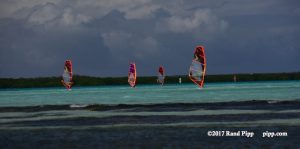
Bonaire is definitely one of the best places for kiteboarding and windsurfing. There is a bay called “Lac Baai” or Lac Bonaire on the southeast part of the island that is sheltered from waves, but still gets the steady easterly trade winds. Whether you’re a beginner or expert, this is an ideal place to play. There are two excellent kiteboarding and windsurfing schools there http://www.jibecity.com/. We have our own trainer kite on Golden Glow so we’re in learning mode!
Salt Production on Bonaire
Perhaps the most distinctive physical feature of Bonarie are its salt flats – they rise like white mountains visible from far offshore without binoculars.
With the steady trade winds and abundant sunshine, turning sea water into salt has been a primary industry on Bonaire for over four centuries. Before refrigeration, salt was essential for preserving meat and fish. Modernization of equipment and technology, combined with the abolition of slavery in the 1800’s, changed the machinery of salt harvesting, but not the basic way it’s done on Bonaire.
Sea water is brought into huge rectangular pools called salt flats (they’re the pink horizontal surfaces in our photos). The wind and sunshine evaporate the water, leaving behind mounds of salt crystals, which are then harvested. Those brisk winds forced us to remember high school chemistry when they blew hard-as-ice salt crystals against our bare skin as we went by the salt flats on our motorbikes.
In the pre-industrial age a few centuries ago, the very hard work of salt-making was performed by slaves, a black mark in Bonaire’s history. The slaves worked long and hard, making it too difficult to go back to their homes for the night during the stretch of time they worked. Instead, they would sleep in tiny “slave huts” near the salt flats.
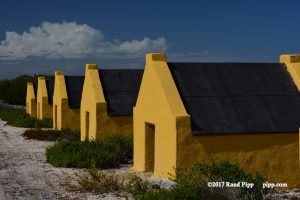 It’s painful to think about how people were plucked from their homes in the eastern Caribbean islands or even Africa and South America and brought to Bonaire to toil as slaves in the salt flats, sleeping in these windowless, baked clay structures. When you stand next to the huts, you are almost as tall as the upper roof line so the slaves would barely have been able to stand up inside.
It’s painful to think about how people were plucked from their homes in the eastern Caribbean islands or even Africa and South America and brought to Bonaire to toil as slaves in the salt flats, sleeping in these windowless, baked clay structures. When you stand next to the huts, you are almost as tall as the upper roof line so the slaves would barely have been able to stand up inside.
Thankfully, today all salt production is mechanized. After the dried salt is collected into the big white mountains we saw as we sailed in, the salt is carried by conveyer belt to the hold of a cargo ship, and from there it goes to a Cargill plant that gets it into final form and distributes it to kitchens and tables all over the world.
Pink Flamingos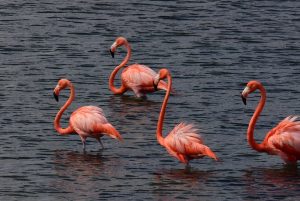
Bonaire is also a famous nesting place for pink flamingos and if you want to see them, there are certain saltwater marshes and ponds where you can be assured to have good sightings.
Pink Flamingos make their home in Bonaire’s salt flats. They eat the pink crustaceons that also are the reason the salt flat pools are pink. This diet is how the flamingos get their salmon pink color.
We spent a long time watching these graceful birds in their natural habitat. Who knew bird-watching could be so interesting!
Leaving Bonaire we saw a flock of flamingoes flying over the sea in v-shaped formation. They were far more graceful in flight than you might imagine such a long-legged bird could be.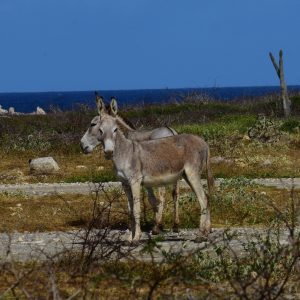
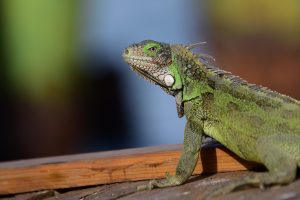
There is other wildlife on Bonaire like donkeys and large lizards, but the pink flamingos were our favorites.
Diving
Bonaire is well known as a diver’s paradise. We used our snuba right off the boat to descend to reefs and watch the fish. And the rest of the time, we saw a steady stream of divers bubbles and undersea lights under the boat as others dove with tanks under us.
Another popular dive spot is near the salt flats, but you can literally walk off the beach anywhere on the west side of Bonaire and snorkel or dive in fish-filled reefs.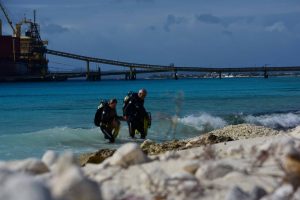
Carnival 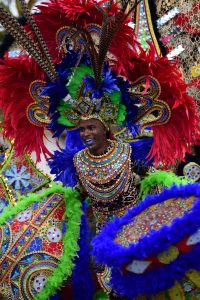
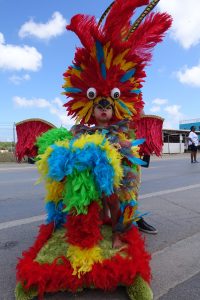
Bonaire’s Youngest Carnival Attraction?
We were lucky to be on Bonaire during its Carnival. Given the small size of Bonaire it seems that everyone gets caught up in Carnival spirit. Everyone – of all ages – participates either in the parade or along the route as the audience. Such costumes, music and dancing! We had a fun afternoon taking it all in.
Scooter Tour of the Island
Seeing Bonaire by motorbike is an ideal way to get around. As we tooled around on our motorbikes, we passed several motorcoaches filled with tourists. While we had full 360 degree visibility and the comfort of the wind in our hair, the tourists sat behind closed glass windows missing the smells and sounds of the birds, the surf and the ocean. Plus, we could – and did – go everywhere on our scooters, including off-road and on the beaches.
Okay, when a brief rainstorm made us wish our sunglasses had windshield wipers, or when the windblown salt from the mountains was stinging our skin, we could have used a little more shelter, but overall we wouldn’t have traded our motorbikes for anything.We were able to comfortably see the entire island in one day, including stopping for a leisurely lunch and plenty of photo stops and detours to see wildlife and sights that caught our eyes.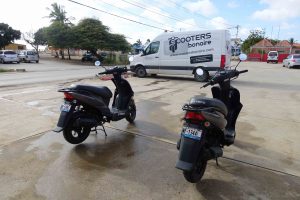
Caribbean Crime
Sadly, Bonaire has a crime problem. During daylight hours, we never saw any hint of crime, but we had heard about some cruisers who were mugged as they walked back to the marina north of Kralendijk town at night. We also were told by the owner of the bike store that if we wanted to rent motorbikes for two days, we’d still have to bring them back to the shop by dark where he would lock them inside until morning. I asked if we could just lock them and leave them parked on the street near the boat and he laughed ruefully and said “oh no, they’d be stripped clean by morning.” Yikes!
When we were at a gas station filling up the motorbikes before returning them and I was paying, the cashier was behind bullet-proof glass – not something I’d seen anywhere in the Caribbean before. Good thing she was. At eye level, there was a deep, round indentation with fracturing spreading out around it like the rays of a sun. I asked and she said “yes, that’s a bullet-hole.” Double-Yikes!!
We rented motorbikes because our bicycles needed new tires, so we left the bikes at the store to be tuned up while we motored around the island. We picked up our bikes and returned the motorbikes and decided to stop for a bite at a café on the shore near where we were anchored. We had a cocktail and some appetizers and returned to a relaxing evening playing acey-deucey and relaxing on the boat.
The next morning, I was up early and found myself going back through the steps the night before…arrive at café…put bikes right behind where we were sitting…drink, eat, chat with owner of café and other cruisers at the bar…pay our bill and return to the boat….grab bikes and return to boat…. Uh oh.
“Rand, do you remember bringing the bikes back to the boat?” It’s not a quick process to break down folding bikes: unhook and lower the seats, take down the handlebars, put in the pedals, collapse the bike into two pieces, Velcro tie them together in two places… I couldn’t recall having done that, or lowered them into the dinghy, or taken them out and put them down into the locker carefully avoiding the engine’s exhaust hose and the watermaker’s delicate equipment.
Sure enough. We had forgotten our unlocked bikes at the bar where we had stopped the evening before. After what the bike shop owner had told us about crime, we felt resigned to the probability that the bikes would be gone, but Rand jumped into the dinghy and raced to shore. As he approached, he was amazed to see our bikes still leaning against the post behind where we had been sitting. He raced faster thinking they might disappear before he could reach the bar.
An hour later, bikes safely stowed in the locker, we were cleaning up from breakfast when we heard a loud knock on the hull. We looked out and saw a large RIB filled with official looking men in several types of uniforms, some with holstered weapons and wearing what looked like flak jackets. Turns out they were local police and detectives.
We welcomed them aboard. “Where were you last night at about 1 am?” one of them asked. “Here. Sleeping,” we replied. “And where were you earlier in the evening?” “We were on shore having dinner at the bar over there,” and we pointed to where Rand had been an hour before retrieving our bikes.
My guess is that the police were watching when Rand picked up the bikes and came to investigate. Surely they didn’t think he had stolen these beat-up, well-worn folding bikes?
The policemen then asked if we’d heard anything the night before, between about 1-3 am. No, we answered, and asked why. It turned out there had been a drive-by shooting and a man had been killed at the bar where we had been eating a few hours earlier. Evidently it was the culmination of a local dispute.
The police then recounted the whole night’s history and sadly, we realized then that the only reason our bikes were not stolen was because police had been staked out at the bar all night after the murder.
As we said, Bonaire felt joyful and clean and safe whenever we were out and about, but that was mostly during the daytime, especially after the murder.
There is a lot to do in Bonaire under its plentiful sunshine.
WINDSURFERS ON LAC BONAIRE from sv Golden Glow on Vimeo.
Thank you Rand Pipp Pipp.com for your fabulous photographs!

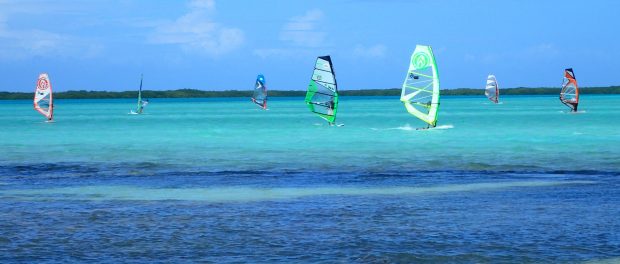


Leave a comment